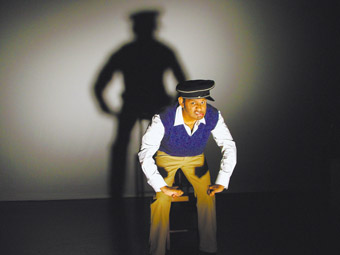Shifting perspectives
Janice Florence on art and disability at Art of Difference

Ramesh Meyyappan, This Side Up
This year’s Art of Difference at Gasworks in mid May was a trailblazer in its approach to disability arts. Steered by a committee of local artists and arts workers, almost all of whom have a disability, the conference/arts event attempted to create “an inspirational catalyst for professional development change and debate.”
Though the term ‘disability arts’ may conjure for many a scenario of passive recipients being lead into ‘happy clappy’ therapeutic arts experiences by non-disabled artists, this event was to some degree successful in dispelling the stereotype. The event drew professional overseas, interstate and local artists with disability, as well as people interested in art as recreation. The program comprised performance, exhibitions, workshops and sometimes heated debate on key issues.
The disability arts community in Melbourne is small and close-knit, though it also has many connections with the local world of mainstream and fringe arts. It was therefore healthy to have disability arts activists from overseas present, to lob a provocative stink bomb or 2 into the debate. Julie McNamara, performer and disability activist from the UK and Phillip Patston, comedian from NZ, obligingly took on this role during debates on the politics of disability arts. Patston, also active in gay politics, remarked that you would never see a room full of heterosexuals in leading roles at a gay conference. Traditionally and still today, non-disabled administrators, directors, and teachers fill the majority of these roles in disability arts. This mildly radical comment caused quite a stir. There was discussion about how change from this traditional model could come about, as indeed it has in recent years in the UK.
Julie McNamara, UK
There was a small but strong performance program. Some shows were open to the public as well as conference goers and attracted good crowds. Julie MacNamara (UK) performed her one-woman show, Pig Tales, the confronting story of a female child raised as a boy, brutalised by organised religion and the psychiatric system. The sometimes grueling narrative, a miasma of chaos and cruelty, was leavened with wry, bawdy, black humour. This was quite a workout for McNamara, skilfully performed and cleverly staged. Steering clear of didactics, the production integrated issues of gender and disability into the personal story of a likeable, confused, mistreated human being.
Ramesh Meyyappan, Singapore
In complete contrast, Ramesh Meyyappan, a deaf mime artist from Singapore performed his physical theatre work, This Side Up, a light-hearted visual narrative about one man’s battle against the urban sprawl. Using traditional mime theatre, an elastic face and expressive eyes, the artist hilariously conveyed a surreal, cartoon-like vision of the mundane world of work. Deaf signing was adapted through mime artistry to become an eloquent set of signals for any audience. Perhaps the experience of deafness has contributed to the intense physical expressiveness of this performer. His show has travelled the world with humour so light and universal it can appeal across borders. Ramesh also lead a very successful series of workshops in physical theatre at Art of Difference.
Phillip Patston, NZ
New Zealand comedian and disability activist Phillip Patston performed with Sue-Ann Post and graduates of a stand-up comedy workshop, run as part of the conference. Patston delivered a wry, ironic take on the experience of disability with sharp insight into living daily as part of an oppressed caste that is still marginalised in many subtle and not so subtle ways. Being downtrodden can be a rich source of humour.
Dance, music, visual arts…
There was a joint work in progress from members of Restless Dance Co from Adelaide and Weave Movement Theatre from Melbourne, which gave useful insights for the many artists and arts workers attending into the genesis of dance performance involving performers with a range of disabilities. There were performances also from Louis Tillett, internationally acclaimed singer-songwriter from Sydney, and Michael Crane, a Melbourne writer who incorporates a wide range of musicians in his performance pieces. Local music artist Akash presented a striking installation. All these artists identify as having a disability, though they do not restrict their work to a narrow preoccupation with disability issues. Other human preoccupations may often seem a more interesting source for art.
The visual arts were well represented in works by artists such as Ross Barber from Queensland, the Colour Gang from Gippsland, Richard Morrison, Glenn Sinclair and Arts Project Australia (www.artsproject.org.au). The local disability visual arts scene is a thriving one, producing much impressive work.
Leadership, access, recognition
There are ongoing political debates to be had around disability arts. Why should it be segregated from the rest of the arts? This mirrors broader social questions around disability and segregation, in general still alive and well, despite slow advances. Why aren’t more people with disabilities in positions of power and leadership in the arts? Why aren’t more people with disabilities accepted into arts training institutions and so on?
Art of Difference has taken a step away from routine ways of looking at disability arts and has given a brief insight into the wide spectrum of artists and arts activity identified with disability. Maybe this can shift perceptions a degree or two. From recreation to high-level creation, art functions in many ways for people with disability, as for the rest of the community. At the same time, there are still many doors to be opened to achieve full access and recognition for these artists and the work they create, work which emerges from a unique viewing platform on the theatre of humanity.
Janice Florence participated in Art of Difference as a dance artist in the Weave-Restless project and as a speaker in several panel discussions.
Art of Difference, Gasworks Arts Park, Melbourne, May 18-20
RealTime issue #74 Aug-Sept 2006 pg. 46






